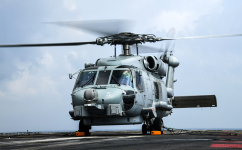
New Delhi: The US has approved a $52.8 million government-to-government deal for the sale of Anti-Submarine Warfare Sonobuoys that will be integrated with the Indian Navy’s Romeo helicopters.
The deal’s approval comes as India and the US ink the non-binding Security of Supply Arrangement (SOSA). Through SOSA, the two countries agree to provide reciprocal priority support for goods and services that promote national defense. The Arrangement will enable both countries to acquire the industrial resources they need to resolve unanticipated supply chain disruptions and meet national security needs.
In other words, in case of armed conflicts or other emergencies, the US will streamline the Department of Defense process and “proactively” allay anticipated supply chain issues.
India is the eighteenth SOSA partner of the U.S. Other SOSA partners include Australia, Canada, Denmark, Estonia, Finland, Israel, Italy, Japan, Latvia, Lithuania, the Netherlands, Norway, the Republic of Korea, Singapore, Spain, Sweden, and the United Kingdom.
The Defense Security Cooperation Agency delivered the required certification notifying Congress of this possible sale Friday.
India wanted the AN/SSQ-53G High Altitude Anti-Submarine Warfare (HAASW) sonobuoys; AN/SSQ-62F HAASW sonobuoys; AN/SSQ-36 sonobuoys besides logistics and support from the US under the Foreign Military Sales route for the MH-60R helicopters already procured from the Americans.
“The high-altitude sonobuoys are the ones used by P-8I aircraft, can be dropped from the air, and have an umbrella-like opening system underwater. It has signal processing units and transmits the underwater signal detected via RF link component attached,” an Indian Navy’s warfare specialist told the EurAsian Times.
In the absence of the high-altitude sonobuoys, the aircraft has to descend to drop so as not to damage the sonobuoys.
These sonobuoys amplify underwater acoustics, can provide both range and bearing to the target for accurate position fixing, and evaluate local effects of seawater temperature on sonar propagation and acoustic range prediction. They can be launched from both rotary-wing and fixed-wing aircraft and the decks of surface vessels.
The US government has said in a statement that the proposed sale will support the US foreign policy and national security objectives. These sonobuoys will be integrated with the MH-60 R helicopters recently acquired by the Indian Navy from the US.
The MH-60R Seahawk is the maritime variant of the battle-proven UH-60 Blackhawk helicopter, which is in service in multiple countries. Equipped for anti-submarine and anti-surface naval warfare, the MH-60Rs will extend the operational reach of Indian naval battle groups across the Indian Ocean region.
With a service ceiling of 20,000 feet, the choppers carry lightweight torpedoes, air-to-surface missiles, and advanced sensors for long-range homing, hunting, and destroying threats posed by enemy submarines and warships.
The Indian Navy also operates Poseidon P-8I submarine hunter aircraft.
The threats of Chinese submarines have been the main focus point of the RIMPAC-2024 as the Indian Navy’s P-8I and other countries hone their submarine hunting skills.
The proposed sale will improve India’s capability to meet current and future threats by enhancing its capacity to conduct anti-submarine warfare operations from its MH-60R helicopters.
The Indian Navy is consistently building up its anti-submarine warfare capabilities.
Earlier this year, the force raised its first squadron of MH-60R helicopters. Two Shallow Water Crafts, ‘Agray’ and ‘Akshay,’ were launched in March this year. In total, the Indian Navy will acquire 16 such SWCs capable of Anti-submarine warfare.
The Indian Navy will also acquire MQ-9B SeaGuardian, which is capable of carrying, releasing, and monitoring sonobuoys to detect enemy submarines. The “Hunter-Killer” can deploy a network of sonobuoys to detect and track enemy submarines, marking a significant advancement in maritime surveillance and anti-submarine warfare.





